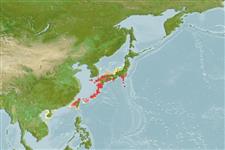Common names from other countries
>
Gobiiformes (Gobies) >
Gobiidae (Gobies) > Gobiinae
Etymology: Eviota: No etymology given, suggested by Christopher Scharpt: from Latin 'eu' for 'true' and 'iota' for anything very small, in combination 'truly very small' referring to it as being the smallest vertebrate at the time it has benn described by Jenkins (thus, making the suggestion by Scharpt plausible.; rubrimaculata: Name as an adjective from the Latin 'rubra' for red and 'macula' for spot; referring to the
distinctive red spots on the head and body..
Environment: milieu / climate zone / depth range / distribution range
экология
морской ассоциированный с рифами; пределы глубины 6 - 8 m (Ref. 104430). Subtropical
распространение
страны | регионы FAO | Ecosystems | места находок | Point map | интродукции | Faunafri
Northwest Pacific: Ryukyu Is., Japan.
Size / Вес / Возраст
Maturity: Lm ? range ? - ? cm
Max length : 1.2 cm SL (female)
Краткое описание
определительные ключи | морфология | морфометрия
колючие лучи спинного плавника (общее число) : 7; членистые (мягкие) лучи спинного плавника (общее число) : 9; колючие лучи анального плавника: 1; членистые (мягкие) лучи анального плавника: 8. This species is distinguished by the following characters: cephalic sensory-canal pore system pattern 2 (lacking only H [IT] pore); some pectoral-fin rays branched (11-15th rays); dorsal/anal fin-ray formula 9/8; absence of the 5th pelvic-fin ray; absence of the following - prominent distinct dark spots on pectoral-fin base, caudal-peduncle spot over preural centrum, postocular spots, and the strong and dark spots on caudal fin; anal-fin base with 2 dark spots; first dorsal fin clear with some light orange on anterodorsal portion and dark distal margin; second dorsal fin with red-orange spots on basal half, distal margin black and yellow; the body with bright red markings (Ref. 104430).
Life cycle and mating behavior
Maturities | размножение | Spawnings | Egg(s) | Fecundities | личинки
Suzuki, T., D.W. Greenfield and H. Motomura, 2015. Two new dwarfgobies (Teleostei: Gobiidae) from the Ryukyu Islands, Japan: Eviota flavipinnata and Eviota rubrimaculata. Zootaxa 4007(3):399-408. (Ref. 104430)
Статус Красного Списка МСОП (Ref. 130435)
CITES (Ref. 128078)
Not Evaluated
Угроза для людей
Harmless
Использование человеком
дополнительная информация
инструменты
Специальные отчеты
Скачать в формате XML
ресурсы в Интернет
Estimates based on models
Phylogenetic diversity index (Ref.
82804): PD
50 = 0.5000 [Uniqueness, from 0.5 = low to 2.0 = high].
Bayesian length-weight: a=0.00708 (0.00333 - 0.01504), b=3.09 (2.92 - 3.26), in cm Total Length, based on LWR estimates for this (Sub)family-body shape (Ref.
93245).
Trophic level (Ref.
69278): 2.9 ±0.3 se; based on size and trophs of closest relatives
устойчивость к внешним воздействиям (Ref.
120179): высокий, минимальное время удвоения популяции до 15 месяцев (Preliminary K or Fecundity.).
Fishing Vulnerability (Ref.
59153): Low vulnerability (10 of 100).
